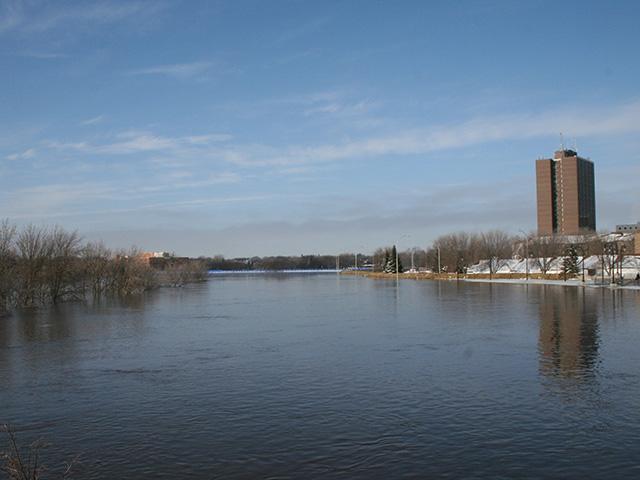ND Dairy Approval Challenged in Court
Lawsuit Challenges North Dakota Mega-Dairy Permit Over Red River Water Quality Concerns
LINCOLN, Neb. (DTN) -- An environmental group argues in a lawsuit that the state of North Dakota erred in granting a permit to Riverview ND, LLP, to build a proposed 25,000-head dairy and should have required the company to have a federal permit as a pollution point source.
The proposed facility would be located about 1.5 miles from the Red River of the North that serves as an international waterway and a source of drinking water.
The lawsuit filed in both Traill and Burleigh counties by Food and Water Watch and the Wild and Scenic Law Center on behalf of the Dakota Resource Council argues the state failed to follow Clean Water Act requirements.
According to the permit approved by the state, the dairy would generate about 204 million to 235 million gallons of liquid manure and wastewater annually. In addition, 12,643 acres are tile-drained, meaning pollutants would drain directly into waterways while there is no requirement to monitor tile drains or to verify compliance with application rates.
The Dakota Resource Council argues the dairy will threaten the Red River and Lake Winnipeg in Canada with nitrogen, phosphorus, bacteria, pathogens, pesticides and other pollutants.
In addition, the lawsuit claims the dairy would endanger 15 nearby residences including two within one mile of the site.
P[L1] D[0x0] M[300x250] OOP[F] ADUNIT[] T[]
The group asked the courts to reverse the state's decision to issue a permit and to require the North Dakota Department of Environmental Quality (DEQ) to reconsider.
"DEQ may only issue an AFO permit if the agency 'determines that the animal feeding operation will not cause nor likely cause pollution of waters of the state, either after upgrades are made or at its current status,'" the lawsuit said.
"Dairies the size of Riverview's Herberg Dairy create enormous amounts of wastes that contain pollutants such as nitrogen, phosphorus, bacteria, pathogens, sediments, pesticides, pharmaceuticals, salts and metals. When discharged to waters, these pollutants pose serious threats to the health and wellbeing of nearby communities and ecosystems. Thus, not only is Herberg Dairy a point source, it is a point source that, if allowed to operate according to the AFO permit and as described in Riverview's AFO permit application, will discharge via at least one conduit to the Red River, which is both a water of the state and a water of the United States."
Riverview LLP operates dairies in Arizona, Minnesota, Nebraska, New Mexico and South Dakota. The company also proposes to build a 12,500-head dairy in Richland County, North Dakota.
The plans in North Dakota are being investigated by the provincial government of Manitoba, as the International Joint Commission directed the International Red River Watershed Board to review the permits.
The North Dakota DEQ issued a 641-page final decision on the permit application on Sept. 24, 2025, explaining why a National Pollutant Discharge Elimination System (NPDES) permit was not required.
"Currently concentrated animal feeding operations permitted in North Dakota are permitted under state rules NDAC 33.1-16-03.1," the state said in response to a public comment.
"The department has the authority to issue a state animal feeding operation permit under (state law). Department approval addresses the health and environmental concerns relating to protecting air quality and water quality. The submitted application and supporting documentation show that the proposed facility is not a point source subject to a NPDES permit. Land application sites from a CAFO are not subject to NPDES requirements if the NMP (nutrient management plan) is followed as specified in (law). Agricultural storm water discharges are exempt from the NPDES as provided in 33 U.S.C. 1362(14)."
The environmental groups also argue the state ignored an engineer's revised calculations showing higher wastewater generation than previously thought. In addition, the lawsuit said ponds on the proposed dairy would be clay-lined and would allow more than 200,000 gallons per acre per year to seep into groundwater.
"Importantly, this is a best-case scenario that does not account for diminished pond integrity from floodwater inundation or freeze-thaw cycles that create cracks in the ponds' clay liners through which additional pollution can (and is likely to) escape," the lawsuit said.
The state permit would require the dairy to land apply waste according to its nutrient management plan.
"Without confirmation of NMP compliance, DEQ has no basis to determine whether inevitable discharges from land-application activities qualify as agricultural stormwater and no way to intervene in time to prevent pollution when discharges occur," the lawsuit said.
Todd Neeley can be reached at todd.neeley@dtn.com
Follow him on social platform X @DTNeeley
(c) Copyright 2025 DTN, LLC. All rights reserved.




